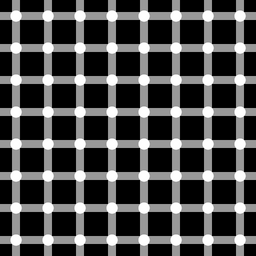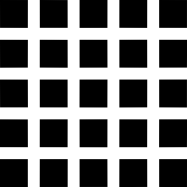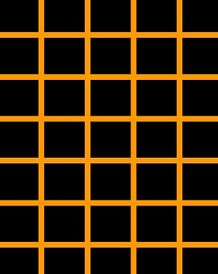
The Scintillating grid illusion
A grid illusion is any kind of grid that deceives a person's vision. The two most common types of grid illusions are Scintillating grid illusions and Hermann grid illusions.
Scintillating grid illusion[]
The Scintillating grid illusion is an optical illusion when dots seem to appear and disappear at the intersections of two lines crossing each other vertically and diagonally. When a person keeps his or her eyes directly on a single intersection, the dot does not appear. A variation of the Scintillating illusion is the Hermann grid illusion (see section below). In the picture on the right, a person should see white dots turn black and then turning white again very fast.
Hermann grid illusion[]

A Hermann grid illusion. Shape position and color contrast converge to produce the illusion of spots at the intersections.
The Hermann grid illusion is an optical illusion reported by Ludimar Hermann in 1870 while, incidentally, reading John Tyndall's Sound. It is very similar to the Scintillating grid illusion.
Like the Scintillating grid illusion, when looking at a grid of black squares on a white (or light-colored) background, one will have the impression that there are "ghostlike" grey blobs at the intersections of the white lines. The grey blobs disappear when looking directly at an intersection.

Another type of Hermann grid illusion.
Differences between the Scintillating and Hermann grid illusions[]
The difference between the Hermann grid illusion and the Scintillating illusion is that Scintillating illusions have dots already in place at the intersection, whereas there are no dots already in place at the intersections of Hermann grid illusions. However, since they are so similar, the two names are commonly switched around.
The cause of both Scintillating and Hermann grid illusions[]
The effect of the optical illusion is explained by a neural process called lateral inhibition. The intensity at a point in the visual system is not simply the result of a single receptor, but the result of a group of receptors called a receptive field.
In the center of the receptive field, the receptors act excitatory on the resulting signal, and the receptors in the surrounding area act inhibitory on the signal. Thus, since a point at an intersection is surrounded by more intensity than a point at the middle of a line, the intersection appears darker. In a person's eyes, the nerve cells of the retina associate and interact with each other, which results in the illusion that there are dots, when there really aren't.
External links[]
- Refutation of classical explanation of Hermann Grid Illusion
- Grid illusion
- Scintillating Grid Illusion – Mathworld
- Giant grid
- Hermann Grid Illusion: Java applet with several parameters
es:Ilusión de la cuadrícula fr:Grille d'Hermann pt:Ilusão da quadrícula
| This page uses Creative Commons Licensed content from Wikipedia (view authors). |